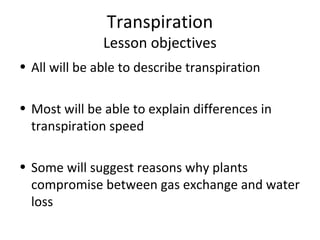Report
Share

Recommended
Recommended
More Related Content
What's hot
What's hot (20)
Chapter 9 Transport in Plants Lesson 3 - The 3 mechanisms in water transport_...

Chapter 9 Transport in Plants Lesson 3 - The 3 mechanisms in water transport_...
Chapter 9 Transport in Plants Lesson 2 - Xylem and Phloem structure and function

Chapter 9 Transport in Plants Lesson 2 - Xylem and Phloem structure and function
Viewers also liked
Viewers also liked (20)
Presentacion VI jornadas Voluntariado Cáritas Toledo

Presentacion VI jornadas Voluntariado Cáritas Toledo
Lifeloc EASYCAL Automatic Calibration Brochure for Workplace Breath Testers

Lifeloc EASYCAL Automatic Calibration Brochure for Workplace Breath Testers
Cómo valoran la RSC y el periodismo social los Medios y los periodistas

Cómo valoran la RSC y el periodismo social los Medios y los periodistas
Seguros agropecuarios y gestión integral de riesgos

Seguros agropecuarios y gestión integral de riesgos
Construyendo Aplicaciones Web con PHP + LUA + REDIS

Construyendo Aplicaciones Web con PHP + LUA + REDIS
xTreme Programming by Sejo Ćesić and Enis Zeherović

xTreme Programming by Sejo Ćesić and Enis Zeherović
Presentación Emilie Vandecandelaere, FAO (spanish)

Presentación Emilie Vandecandelaere, FAO (spanish)
Similar to Mrs Abrey Lesson 5 transpiration
Similar to Mrs Abrey Lesson 5 transpiration (20)
Running headThe effect of Temperature, Wind and Hum.docx

Running headThe effect of Temperature, Wind and Hum.docx
plant water relation, transpiration, root pressure and transpirational pull.pptx

plant water relation, transpiration, root pressure and transpirational pull.pptx
Biology Form 5 Chapter 1 : 1.7- 1.8 transport in plants

Biology Form 5 Chapter 1 : 1.7- 1.8 transport in plants
More from karthinava
More from karthinava (18)
Mrs Abrey Lesson 5 transpiration
- 1. Transpiration Lesson objectives • All will be able to describe transpiration • Most will be able to explain differences in transpiration speed • Some will suggest reasons why plants compromise between gas exchange and water loss
- 2. How do tall trees get enough water? Redwoods are the tallest species of tree in the world - the tallest was 120 metres. How does a plant this size get water from its roots to the branches at the top? What experiment could show that water travels up stems?
- 3. Transpiration Transpiration can be measured using a potometer. A cut plant stem is sealed into the potometer using a rubber bung. An air bubble is introduced to the capillary tube. The distance the bubble travels shows how much water the stem has taken up.
- 5. 1. Record a definition of transpiration 2. Where do plants lose water? 3. Transpiration will often lead to water loss by the plant so what is its purpose and what is the major advantage?
- 6. Transpiration • Sort the statements out into the correct order to show how water moves to the top of the plant
- 7. Transpiration Experiment Distance bubble moved after each minute in mm Time in 1 2 3 4 5 6 7 8 9 10 min A 2 3 5 7 10 11 13 15 18 20 B 13 24 38 49 73 75 89 114 118 152 C 5 12 18 24 30 35 41 47 53 58
- 8. Is the rate of transpiration constant? Transpiration is a bit like a straw, pulling water up the plant. Sometimes the pulling force will be stronger and the plant will lose more water. The speed at which a plant loses water is called the rate of transpiration. What environmental factors will affect the rate of transpiration? humidity (amount of moisture in the air) light intensity temperature air movement (wind).
- 10. How does a plant control water loss? 1. Waxy waterproof layer (cuticle) 2. Stomata on the underside of the leaf (not expose to sun) 3. Wilting. Leaves collapse reducing surface area 4. Stomata close
Editor's Notes
- Photo credit: © 2007 Jupiterimages Corporation
- Teacher notes This four-stage animation uses close-up illustrations of the roots, stem and leaves to show what happens in the different part of a plant during transpiration. Suitable prompts include: Start: What is transpiration? Stage 1: How do root hair cells increase the diffusion of water? Stage 2: Which plant tissue transports water? Stage 3: Through what part of the leaf does water evaporats? Stage 4: What will happen to the water after it has evaporated into the air? See the ‘ Movement In and Out of Cells ’ presentation for more information about osmosis and concentration gradients.
- Teacher notes This activity provides illustrated explanations about why certain environmental factors influence the rate of transpiration. It could be used to introduce the topic or for revision purposes.